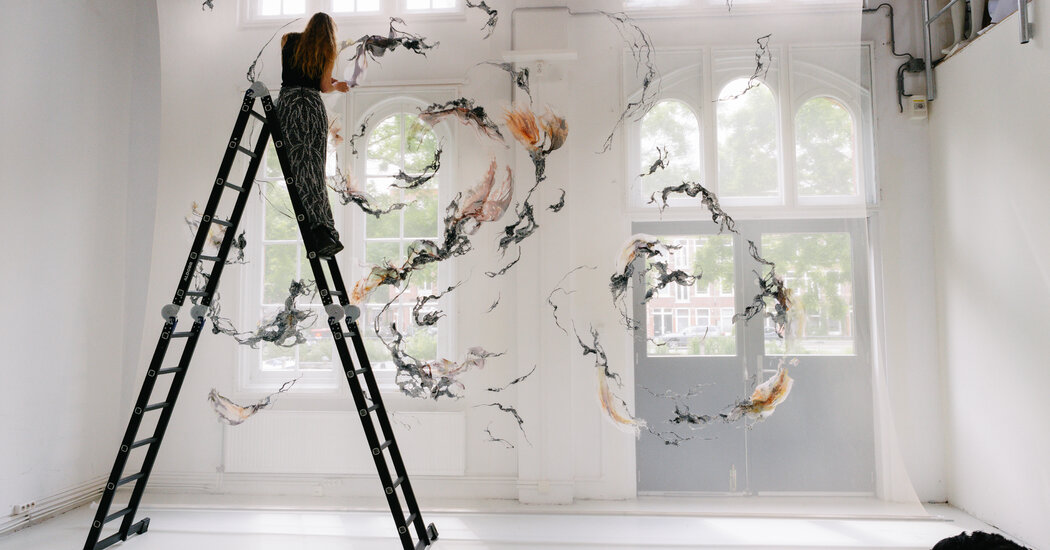Dutch fashion designer Iris van Herpen, who counts Beyoncé, Björk and Tilda Swinton among her regular clients, is known for dazzling haute couture pieces that resemble sculpture.
Now she wants to show that the comparison also works the other way around: she is not a fashion designer, but an artist who happens to create pieces for the body.
Van Herpen is planning an art exhibition called ‘Hybrid’, which took a year to complete but will last just 45 minutes on June 24, as part of Paris Haute Couture Week.
Why only 45 minutes? That’s shorter than a yoga class, some Netflix episodes, or a nap.
Compared to her usual presentation at Fashion Week, that is actually quite long, according to the designer.
“We normally do a catwalk show that only lasts 15 minutes because the audience goes from one show to the next. So this is a very long time for this setup,” she said. “This show is truly a hybrid performance,” she added. “There are live artists performing the installation and it will be physically intense.”
On a recent afternoon, Van Herpen welcomed a reporter into her airy studio in the center of Westerpark, a complex of former electricity company buildings in a lush green park in western Amsterdam.
It is one of her two studios in the Dutch capital; her couture studio, a 12-minute walk away, where she creates what she calls her “body works,” did not have enough height to hang her largest new works of art. Here they dangle 5 meters above the rafters.
In front of the arched windows that frame the constantly moving clouds, a tulle curtain hangs, decorated with swirling shapes made from dried splashes of oil paint and painted silk. This is one of her latest pieces, ‘The Weightlessness of the Unknown’, among the sculptures to be shown in Paris.
Above, three more strips of tulle are stretched along steel poles, forming a ‘canvas’ for designs made from silk organza pleats and 3D printed objects. The decorative patterns can consist of prehistoric fossils, skeletons or fallen birds decomposing on a beach – or rather an imaginary combination of all three.
“My work has always been interdisciplinary,” she continued, “and I really feel such a strong connection between art, architecture, science and couture. That is what I am doing with the exhibition,” she added, in an effort to “let go of the boundaries we have set for ourselves, as creators and for the audience.”
Tulle, silk and 3D printing have long been some of Van Herpen’s favorite materials, which she has used to create dresses and outré headdresses that are both regal and accomplished. Her fashion pieces are simultaneously futuristic and primordial and refer to her fascination with science and anthropology, but also with contemporary art.
But after fifteen years of collecting ‘looks’ for a major retrospective, ‘Sculpting the Senses’, at the Museé des Arts Decorative in Paris (it closed in April) – and designing custom dresses for Queen Máxima of the Netherlands and the French first lady, Brigitte Macron – Van Herpen realized she had a different ambition.
Creating works that don’t relate to the human form is “exploring a new domain within my own creative process,” she said. “The body is such a focus that for me it was really about finding freedom. I wanted to see what I create outside the body, because I think there is more to it than just couture.”
It was also, in part, to slow down. Until 2023, Van Herpen produced biennial catwalk shows of her collections for 17 years. In January, she decided to skip the Spring 2024 collection exhibition in Paris to focus on her new artwork.
Van Herpen calls the resulting exhibition a “hybrid art installation,” which will include a total of nine works: four large works in her Westerpark studio and five others that will include people she calls “performers.”
They will not trot down the catwalk, as models do at a typical fashion show, but will be suspended, ‘using an invisible structure’, which allows them to remain in place. During the single show, she explained, the performers will remain largely motionless and elevated.
She admitted that presenting the works in this way “will be quite a challenge. You should not be afraid of heights,” she added. “You have to be very grounded.”
Because she expects the audience to include the fashion press, museum curators and other people from the art world, she thinks the 45-minute running time will exceed everyone’s expectations. “For some people it will take a very long time and for others it will take a very short time,” she says. Benches are placed in the gallery space for spectators, just like in a museum.
Van Herpen said she is currently in discussions with a museum to exhibit the works on a more permanent basis from early 2025. But she could not yet release details.
Her tulle ‘canvas’, both sheer and solid, is often used in ballet costumes – a reminder that Van Herpen was once a dancer. On that shimmering surface, she added sculptural elements, such as layers of oil paint, encrusted in thick impasto, and designs made from both hand-pleated silk and 3D printing.
For one of the new works, ‘Ancient Ancestors’, she was inspired by research from Emmanuel Farge, a French biochemist at the French Institut Curie, a center for cancer research and treatment. Farge discovered that the cell structure of primordial marine organisms was determined in part by the motion of waves.
The 3D sculptural elements embedded in the tulle resemble horseshoe crabs and seabird skeletons. “The structures refer to the past but also to the future, because these organisms are constantly changing,” says Van Herpen.
She described the two largest hanging sculptures, “Weightlessness of the Unknown” and “Embers of the Mind,” as self-portraits, although they are completely abstract – more reflective of her emotional state.
In recent years, her inner life has focused on transformation, she explained. She moved from Amsterdam with her friend and collaborator, Salvador Breed, to The Twiskea wetland nature reserve about half an hour’s drive north of the city, known for its many bird species.
During long daily walks with her dog, she explained, she often thinks about nature’s ability to decompose and regenerate. “My focus now is more on a transition than a fixed state of being,” she said.
Does Van Herpen expect to continue to explore the field of art and perhaps distance himself from the limitations of making clothes for the human body?
“I can never see the future, but I know this is permanent,” she said, referring to her shift toward visual art. “I’m someone who needs those different influences; if I only focus on one thing… it just doesn’t give me the right dynamic.”
She added, “I’m not leaving couture, but I’m also not leaving this other” – she paused, searching for the precise word – “dimension.” I really intend to take the liberty of working on the pieces that I think need to be released at that time.
‘Hybrid’, the new exhibition by Iris van Herpen, runs on June 24 at 11:30 am at Boulevard Haussmann 53 in Paris.





